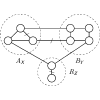Probabilistic inference in the era of tensor networks and differential programming
引用次数: 0
Abstract
Probabilistic inference is a fundamental task in modern machine learning. Recent advances in tensor network (TN) contraction algorithms have enabled the development of better exact inference methods. However, many common inference tasks in probabilistic graphical models (PGMs) still lack corresponding TN-based adaptations. In this paper, we advance the connection between PGMs and TNs by formulating and implementing tensor-based solutions for the following inference tasks: (A) computing the partition function, (B) computing the marginal probability of sets of variables in the model, (C) determining the most likely assignment to a set of variables, (D) the same as (C) but after having marginalized a different set of variables, and (E) generating samples from a learned probability distribution using a generalized method. Our study is motivated by recent technical advances in the fields of quantum circuit simulation, quantum many-body physics, and statistical physics. Through an experimental evaluation, we demonstrate that the integration of these quantum technologies with a series of algorithms introduced in this study significantly improves the performance efficiency of existing methods for solving probabilistic inference tasks.

张量网络和微分编程时代的概率推理
概率推理是现代机器学习的一项基本任务。张量网络(TN)收缩算法的最新进展使人们能够开发出更好的精确推理方法。然而,概率图形模型(PGM)中的许多常见推理任务仍然缺乏相应的基于 TN 的适配方法。在本文中,我们为以下推理任务制定并实现了基于张量的解决方案,从而推进了 PGM 与 TN 之间的联系:(A) 计算分区函数,(B) 计算模型中变量集的边际概率,(C) 确定变量集最可能的分配,(D) 与 (C) 相同,但在对不同变量集进行边际化之后,(E) 使用广义方法从学习到的概率分布生成样本。我们的研究受到量子电路仿真、量子多体物理学和统计物理学领域最新技术进步的推动。通过实验评估,我们证明将这些量子技术与本研究中引入的一系列算法相结合,可显著提高现有方法解决概率推理任务的性能效率。
本文章由计算机程序翻译,如有差异,请以英文原文为准。
求助全文
约1分钟内获得全文
求助全文

 求助内容:
求助内容: 应助结果提醒方式:
应助结果提醒方式:


